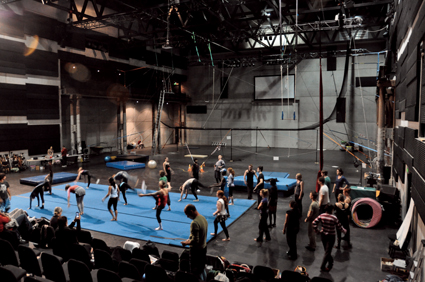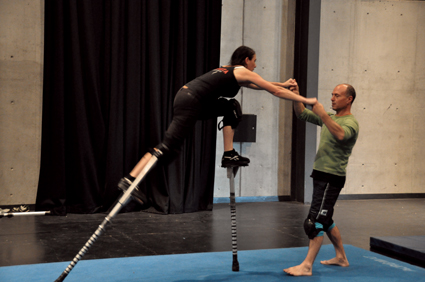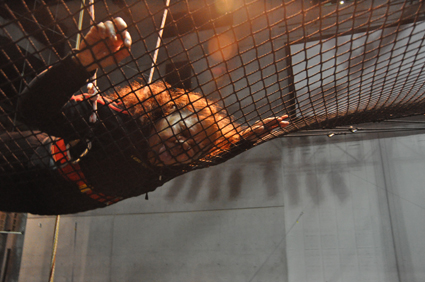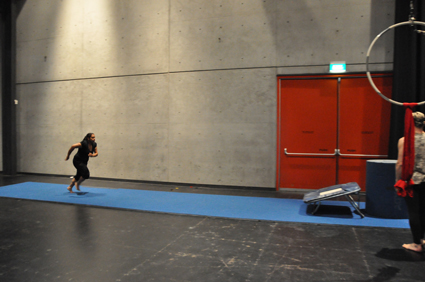building an indigenous physical theatre future
simone o’brien: heads up 2010: indigenous & social circus

Indigenous and Social Circus Skills Workshop
photo Simone O’Brien
Indigenous and Social Circus Skills Workshop
OVER 50 INDIGENOUS AND COMMUNITY CIRCUS ARTISTS FROM ALL OVER AUSTRALIA GATHERED AT CARRIAGEWORKS, SYDNEY IN JULY TO ATTEND HEADS UP 2010, THE FIRST NATIONAL INDIGENOUS AND SOCIAL CIRCUS CONFERENCE AND PROFESSIONAL DEVELOPMENT PROJECT. PHYSICAL THEATRE PERFORMER, WRITER AND DIRECTOR SIMONE O’BRIEN WAS ONE OF THE ORGANISING COMMITTEE. REALTIME ASKED HER TO REPORT ON THIS SIGNIFICANT EVENT FOR INDIGENOUS PERFORMERS.
An exciting array of circus and physical theatre artists was brought together for the first time by Heads Up 2010, united by their passion for gutsy, raw and determined circus and physical theatre. Over the week, rising stars and established luminaries gathered to learn skills, develop material and create a showcase performance, Flying, which opened the weekend conference.
The depth of raw talent and finely tuned skills among these emerging and established circus artists was as huge as the geographical divide and the distances travelled to overcome it. Artists participating included Blackrobat from Koranda in far northern Queensland, who are one of Australia’s longest running Indigenous acrobatic troupes; two of the young Chooky Dancers from Elcho Island; Broome’s Sandfly Circus; Lismore’s Creative People’s Collective; Slippry Sirkus from Wauchope, NSW; Circus Monoxide, Wollongong; senior students from Airds High, NSW; Aerialize, Sydney; the Flying Fruit Fly Circus; Vulcana Women’s Circus, Brisbane; Westside Circus, Melbourne; Circus Ruccis, Melbourne; and Slipstream Circus from Ulverston, Tasmania. There were independent artists such as Louise Moriarty who has run many projects in Broken Hill, some in partnership with Cirque du Monde and the National Institute of Circus Arts (NICA); Jill Watkins from Gunnedah, NSW; Ira Seidenstein, Mikayla Anderson, Natano Fa’anana and Donna Carstens from Brisbane; Felicity Horsley from Melbourne and Nellie Simpson and Michael Smith from Perth.
Many of these artists also spoke at the weekend conference attesting to the incredible benefits of social circus programs. They gave moving accounts of their personal and professional experiences in making profound differences to young people’s lives. One stand out example is the story of Michael Smith and Nellie Simpson.

Larissa Deak and David Clarkson, Indigenous & Social Skills Workshop
photo Simone O’Brien
Larissa Deak and David Clarkson, Indigenous & Social Skills Workshop
talent in the long-term
Michael Smith is a rising Indigenous dance and circus star from Western Australia, currently studying second year dance at the Western Australian Academy of Performing Arts (WAAPA). He was 10 when he met Nellie Simpson, a circus artist at a pilot community circus project in Hilton, a suburb of Perth largely populated by Indigenous people and older generations of war veterans. Michael became an immediate circus enthusiast and, as the project grew, he became an instrumental link between Nellie and the community, travelling in the van with her as she collected kids to take to the project, providing helpful information about people’s whereabouts and family situations.
Nelllie Simpson’s holistic approach to her work was a source of inspiration for Michael as he felt that he was engaged in something more than just a project, that he was part of a philosophy. Many of the artists at the conference agreed on the importance of long term and holistic approaches in effecting real change; as Nellie put it, “Change happens slowly and over time.” Inevitably, questions about sustainability arise when looking at long-term strategic development and ongoing support for the sector in Australia.
stop the circus leaving town
From a bunch of circus vagabonds turning up to an outback town or housing estate to teach a bunch of bored kids to the high profile ventures of Cirque du Monde (an international social circus initiative between Cirque du Soleil and Jeunesse du Monde, a youth focused NGO) questions about the usefulness of short-term projects arise. What happens once the circus leaves town? As a young Brewarrina participant summed it up for the departing artist: “Thanks for fuckin nothin”, a kind of thanks-for-showing-us-what-we-haven’t-got. For some of these young people, the future can appear worse.
The sector has seen tremendous growth over the past decade as many Indigenous and non-indigenous communities have embraced social circus as an effective model for community engagement. Paul Woodhead, a high school teacher and founder of Circus West in Dubbo, noted that there were 60–80 schools in Western NSW alone that had circus programs and that he had worked with 5,000 students over 20 years in youth circus programs, and 350 of them had performed publicly.

Aunty Malu aka Marlene Cummins (Redfern Women’s Traditional Dance Group), Indigenous & Social Skills Workshop
photo Simone O’Brien
Aunty Malu aka Marlene Cummins (Redfern Women’s Traditional Dance Group), Indigenous & Social Skills Workshop
liberated by circus
Donna Carstens, an Indigenous circus artist from Brisbane, now living in Sydney, discussed her project, Behind Closed Bars, which taught circus skills to young people whose mothers were in detention. Donna delivered the project with Sisters Inside, an organisation set up to support women in detention and their children. With the massive overrepresentation of Indigenous people in detention, most of the children involved in the project were Indigenous. Donna worked with the kids to create a circus show, which would then be videoed and sent to their mothers. It would take another two years before the video was seen in prisons.
The Behind Closed Bars initiative won a National Crime Prevention Award because from 60 participants only one went back to juvenile justice while others went on to do TAFE courses. One of the most moving stories came from a young girl who said that before she started the project she felt she had nothing to live for as her mum was in gaol and that she didn’t go to school and had been sniffing glue and petrol. Since doing the circus project she had found something she absolutely loved doing and couldn’t wait for the next class so she could climb on the trapeze. She had found something to be proud of and which she could show her mum when she got out.
Donna’s own story of circus helping her to escape the juvenile justice system was echoed by Noel Tovey. Noel opened the conference speaking about his experiences as an Indigenous artist who was on the street at 11, in gaol at 17 and dancing at Sadler’s Wells in London at 24. He cites the arts as his saviour, stating that if not for the performing arts he would not be here today as it strengthens and promotes Indigenous culture on a personal, spiritual and social level.

Alisha White, Indigenous & Social Circus Skills Workshop
photo Simone O’Brien
Alisha White, Indigenous & Social Circus Skills Workshop
the circus opportunity
Wendy Holland, an Indigenous academic and Associate Professor at University of Western Sydney, spoke at the opening of the conference with a paper entitled “Re-imagining Aboriginality to the Circus Space.” This fascinating talk traced Wendy’s family connections to Aboriginal circus performers travelling Australia in the late 19th century, her great grandparents being respected performers in the Fitzgerald Brother’s Circus. Wendy spoke of the opportunities the performing arts offered her ancestor Harry Kadellar in south-western Queensland in 1888, where he was ‘taken’ as a child into the circus. This gave him the opportunity to train as an equestrian acrobat from age five onwards and a better chance at survival (two years after he was taken from his family, his mother died of strychnine poisoning).
The circus was a place where Harry could celebrate and capitalise on his difference, providing him with income, travel and a diverse and ‘exotic’ family in which he could find his niche. Today social circus offers Indigenous and marginalised young people similar opportunities to rise above their circumstances through skills development, determination and talent to create a better life, however without adequate industry and government support, this may prove to be true for only a handful of artists.
the national view
One of the aims of Heads Up was to bring all the relevant stakeholders together to gain a national perspective on developments in the sector. Audiences heard from Marrugeku, Circus Oz, Legs on the Wall, Redfern Community Centre, Moogahlin Arts, National Institute of Circus Arts, Orana Arts, the Brewarrina Youth Circus, the Chooky Dancers, the Australian Circus and Physical Theatre Association and many of the artists mentioned above. This presented a unique opportunity to discuss the issues affecting the national development of the sector, such as on-going access to resources, training facilities and further career pathways and employment options and ways to identify strategic and sector wide approaches to address these issues.
flying
The other reason for the event was to bring together a unique set of highly talented artists and give them access to professional skills development and performance opportunities. The resulting showcase performance was an exciting blend of traditional dance, gender bending, short films, acrobatics and hip hop, dance and circus and an all-in group dance led by the Chooky Dancers. Raw talent flew beside highly trained technique, aerial routines were imbued with traditional dance. It was a fruitful skill share and rich cross fertilisation between Indigenous and social circus artists from all over Australia who had not had the means to work together before. It was an amazing week of workshops, performances, histories and testimonies that reflected the resilience of Indigenous cultures and closed the gap, bringing the sector together.
the future
Kate Reid from the Brewarrina Youth Circus was the main instigator of Heads Up. Her hopes for the future include “more inclusion of Indigenous artists and leaders across the board in the national circus industry…in order to develop realistic training options, artistic and managerial positions for Indigenous artists and leaders to help foster the development of the Indigenous circus arts sector from within existing organisations and in assisting new groups, programs, training centres and artists as they emerge.”
Heads Up 2010 organising committee: Kate Reid (Brewarrina Youth Circus), Josh Bond (Chooky Dancers), Lily Shearer (Redfern Community Centre and Moogahlin Arts), Simone O’Brien (Legs on the Wall). Major sponsors included CarriageWorks, Legs on the Wall, Redfern Community Centre, the Australian Recreational Centre for Aerial Arts and the Brewarrina Youth Circus. Financial assistance for this Project was provided by Arts NSW and the Federal Government through the Department of Health and Aging and the Indigenous Sport and Recreation Program.
Heads Up 2010, Indigenous and Social Circus Conference, CarriageWorks, Sydney, July 12-18
RealTime issue #99 Oct-Nov 2010 pg. 2-3






